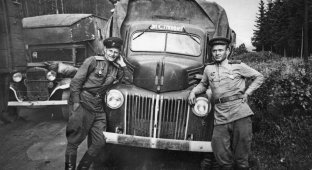Unknown GAZ all-terrain vehicles that did not go into production (31 photos)
Soon after the war, in the quiet of secret special design bureaus (SKB), active work began on new types of future vehicles for the Soviet army. The result of their activities was a huge fleet of unique, highly classified all-terrain vehicles and entire families of experimental army trucks and tractors, created on the basis of conventional production vehicles of a classical design.
The most active developers and manufacturers of new equipment were the Gorky, Ural and Kremenchug automobile plants. All tests of secret cars were carried out by the 21st Scientific Institute of the USSR Ministry of Defense (21 NIII) from the town of Bronnitsy near Moscow. Kolesa.ru is starting a series of publications dedicated to these unique cars, and we will start with GAZ.

At the Gorky Automobile Plant in the 1950s and 1960s, all work on new army equipment was carried out by the secret Special Vehicles Design Bureau, where all serial products underwent strict testing for the possibility of their use as a base for future military all-terrain vehicles.
The first mobile base of the new technology was the simple army vehicle GAZ-69, on the basis of which a series of experimental wheeled and tracked vehicles with fundamentally new types of removable propulsion systems, often without foreign analogues, were developed. The simplest was the GAZ-69, mounted on four wheels with wide-profile arched tires. His version had only rear arched propellers and front skis.
Experienced all-terrain vehicle GAZ-69 on arched tires (from the archive of I. Paderin)

GAZ-69 with rear arched wheels and front skis (from the archive of I. Paderin)

The most original was the all-terrain vehicle with the so-called milling propulsors - metal wheels with sharp blades that cut narrow deep trenches in the snow or ice crust, reaching the frozen ground. In a simplified version, two cutters were hung on both sides of the body. Shortened tracked movers with a triangular outline of rubber-metal belts were also mounted on the GAZ-69.
Snowmobile with milling propulsors and support skis (from the archive of S. Vechkov)

All-terrain vehicle GAZ-69 with side driving cutters (from the archive of I. Paderin)

GAZ-69 car on four driving tracks (from the archive of S. Vechkov)

At NAMI, as part of secret work on highly elastic propulsion, experimental half-track all-terrain vehicles with two types of pneumatic tracks were based on the modified GAZ-69. They attracted the military with their high cross-country ability in sandy and swampy terrain, their smooth and quiet running. The latest model, the S-3MU, with elastic, hingeless tracks and separate pneumatic tracks, was considered the most advanced. All these machines never left the experimental stage and did not live up to the hopes of their creators.
All-terrain vehicle S-3MU with pneumatic tracks (from the archive of A. Karasev)

The second experimental base in chronology was the multi-purpose all-wheel drive GAZ-62 vehicles of the first series, on the units of which the first and only Soviet light four-axle army vehicle was created, both in land and amphibious versions.
GAZ-62B/GAZ-62P (1956 – 1957)
In 1955, during the search work for the future four-axle armored personnel carrier BTR-60P, engineer V. N. Kuzovkin, under the leadership of lead designer A. M. Butusov, developed a project for the all-wheel drive all-terrain vehicle-swamp vehicle GAZ-62B with a carrying capacity of 1.2 tons with independent suspension and all single-pitched drive wheels.
In the spring of next year, it was built in the form of a workable prototype for testing a fundamentally new, unconventional drive system. The car received a 90-horsepower engine from the GAZ-12 passenger car, a transfer case, a sealed brake system, front facing and tail from the experienced bonneted all-terrain vehicle GAZ-62, as well as a new elongated all-metal body with a tailgate, longitudinal benches and a common awning with viewing windows.
Experienced 90-horsepower all-wheel drive vehicle GAZ-62B. 1956

All-terrain vehicle GAZ-62B with four front steered wheels

The car used an original search transmission designed by engineer Boris Akimovich Dekhtyar with a centrally located transfer case and through bevel main gears of both middle axles with cam limited slip differentials, from which torque was redistributed to the outer axles. All low-pressure tires were equipped with an air pressure regulation system. With a total weight of more than 4 tons, the all-terrain vehicle developed a maximum speed of 80 km/h on the highway. Military evaluation tests carried out in August 1956 ended in complete failure for him.
Summer tests of the GAZ-62B multi-purpose vehicle off-road

Winter tests of the 1.2-ton cargo-passenger all-terrain vehicle GAZ-62B

In the same year, using GAZ-62B units, Gorky shipbuilding plant No. 112 "Krasnoe Sormovo" developed and assembled two trial prototype amphibians GAZ-62P with power output to a water cannon and open displacement aluminum hulls without doors, manufactured at aviation enterprise No. 21.
First, both cars underwent a cycle of factory tests, and in November-December 1957, one of them was presented at the NIIAP test site in Bronnitsy, where comparative tests were carried out with larger prototypes of the Moscow Automobile Plant. The floating GAZ-62P turned out to be a low-power and overweight vehicle with insufficient cross-country ability and maneuverability. It was not recommended for mass production, and its unique but overly complex transmission was no longer used.
Experimental amphibian GAZ-62P with an all-metal body. 1957

Field tests of the GAZ-62P all-terrain vehicle (still from NIIAP filming)

The cycle of searching for new efficient all-terrain propulsion systems has not bypassed the famous two-ton army truck GAZ-66. Experimental secret work of the GAZ Design Bureau in the early 1960s was carried out mainly on the basis of its various versions and was limited to installing them on different types of leading systems.
These included traditional half-track versions and vehicles with compact, removable track movers that were put on the vehicle instead of the rear or all four drive wheels. Such all-terrain vehicles were created primarily for movement on virgin snow and therefore received the general unofficial marking GAZ-66S - “snowmobile”.
At that time, prototypes of fully tracked vehicles with individual propulsors designed by S. S. Nezhdanovsky with a triangular outline of four lightweight tracks were considered the most advanced. The first version on the GAZ-66B chassis with an open cab was equipped with trackless cable tracks with upper drive sprockets and two tension drums.
GAZ-66B with lightweight tracked propulsion systems (from the archive of S. Vechkov)

Later, a reinforced rubber-metal propulsion unit with a peripheral frame and two large support wheels was tested on a production GAZ-66 truck with an all-metal cab. In fact, such complex and bulky designs did not lead to a significant increase in the vehicle’s cross-country ability, and work on them was eventually closed.
GAZ-66S vehicle with reinforced tracked propulsion systems (from the archive of S. Vechkov)

Four-track snowmobile on a GAZ-66 chassis (from the archives of I. Paderin)

One of the few special army vehicles that was classified “top secret” for a long time was the significantly modified and strengthened GAZ-66-32 chassis, produced at the Gorky Automobile Plant in 1972. Unlike all other versions of the 66th family, it was equipped with a 140-horsepower V8 carburetor engine from the BRDM-2 combat vehicle. For him, Bronnitsky 21 Research Institute designed, and pilot plant No. 38 assembled, a special sealed van body, KPP-66, with increased resistance to the effects of the shock wave of weapons of mass destruction, which protected the crew from radioactive, chemical and bacteriological contamination. It had two front side doors and a rear double door with a folding ladder, its walls were made of multi-layer synthetic panels with metal reinforcements and lead sheets.
Car KPP-66 on the GAZ-66-32 chassis. 1973 (from the archives of I. Paderin)

KPP-66 staff van at a military training ground (from the archives of 21 NIITs)

It was planned to house senior field headquarters and sanitary evacuation equipment in such a van. Testing of the car began in October 1973 and continued throughout the next year, but such an original and non-standard car did not go into production.
The second direction of GAZ's development activities was the creation of samples of all-wheel drive army trucks GAZ-34 and GAZ-44, as well as the dual-purpose road vehicle GAZ-33.
GAZ-34 (1964 – 1968)
With the launch of serial production of two-axle GAZ-66 trucks, factory designers, unnoticed by prying eyes, began creating a three-axle version of the GAZ-34. It was developed in accordance with the technical specifications of the State Committee for Automotive, Tractor and Agricultural Engineering, although it was a typical military truck-tractor - a lightweight, hoodless alternative to the ZIL-131 bonneted vehicle. The lead designer of the car was Vasily Kuzovkin.
In the army, the GAZ-34 was planned to be used as a medium-sized flatbed truck for delivering cargo and military personnel, installing military equipment and towing light guns. A prototype was assembled in 1964, followed by two cars with pre-production GAZ-66 cabs. In 1967, three more test trucks with production cabs appeared.
Experimental three-ton truck GAZ-34 of the first series, 1964 - 1965.

Externally, a three-ton GAZ-34 with a 115 hp gasoline engine. With. resembled an extended GAZ-66, to which a third bridge was added. In a number of units and components, it was unified with the serial GAZ-66A, but from the very first samples it was equipped with a tire pressure regulation system. One of the few proprietary components was an extended frame and a cargo platform with benches for 27 soldiers and an awning. A number of components were borrowed from ZIL tractors.
Testing of the GAZ-34 truck of the second series on spring off-road conditions

GAZ-34 with a metal body for transporting military personnel

All vehicles were tested for five years in different regions from Moscow to Ashgabat and Ukhta, at training grounds and on the ground. They towed trailers, mortars, a 122 mm M-30 howitzer and even an An-25 aircraft. Based on the test results, the GAZ-34 was recommended for adoption, but with the organization of serial production of the more powerful and reliable ZIL-131 truck, the military’s interest in this vehicle melted away.
Testing of the GAZ-34 car of the second series in Turkmenistan (film frame)

Towing a trailed mine spreader PMR-3

GAZ-34 with trailed compressor ZIF-55

GAZ-34 tractor with a 122 mm M-30 trailed howitzer (film frame)

GAZ-44 (1972 – 1973)
In the early 1970s, the plant attempted to produce heavy army trucks, undertaking the development of a family of unified floating two-, three- and four-axle army vehicles with a carrying capacity of two to five tons. The GAZ-44 was designed in the factory design bureau of trucks under the leadership of Alexander Butusov on the basis of the technical specifications of 21 Research Institutes, developed within the framework of the development theme "Universal-1". It envisaged the creation of a universal range of army all-wheel drive vehicles with maximum unification with civilian vehicles and wheeled armored vehicles, capable of equally easily moving on land and swimming across narrow water areas.
Truck GAZ-44 of the Universal-1 family with a 140-horsepower diesel engine. 1972

The second version of the GAZ-44 with a 210-horsepower engine (from the archives of 21 NIITs)

Floating five-ton military vehicle on the chassis of the BTR-70

The only version built was the four-axle, five-ton GAZ-44 truck, assembled in 1972 in two copies on the chassis of the BTR-70 armored personnel carrier (GAZ-4905). The first sample had a 140-horsepower GAZ-41 V8 gasoline engine from the BRDM-2, the second one had an experimental 210-horsepower YaMZ-740 diesel engine, created for trucks of the Kama Automobile Plant. They were placed longitudinally in the engine compartment behind the forward cabin. The vehicles were equipped with a sealed frame-supporting hull base, two water cannons and a metal platform with a tailgate.
Loading a GAZ-66 army truck onto a floating GAZ-44 vehicle

Transportation of a GAZ-66 car in the onboard body of a GAZ-44 amphibian

Landing of the GAZ-44 amphibian with a sealed load-bearing base

GAZ-44 prototypes successfully passed factory and military tests, but could not compete with similar special equipment from the Bryansk and Minsk Automobile Plants. Failures with such Ural amphibians forced us to abandon further work on this topic. And in our next publication we will study the Ural all-terrain vehicles, unknown to the general public. Stay with us!






















